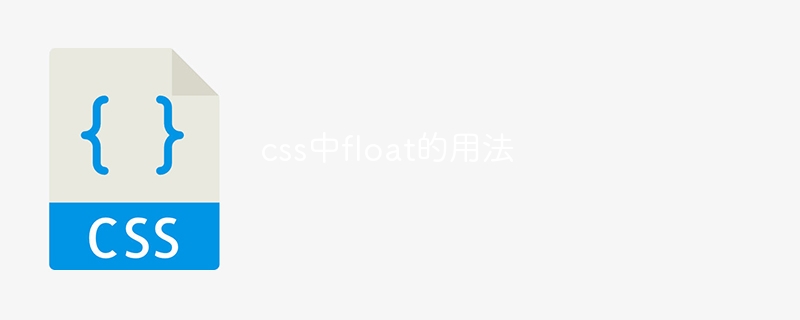Usage of float in css
The float attribute floats the element on the page and displays it side by side with adjacent elements without affecting the regular fluid layout. The float values are: left (left float), right (right float), none (clear float). Floated elements affect content overflow, spacing, and parent container height. Methods for clearing floats include: clearing attributes, floating elements, and overflow: hidden.

Usage of float in CSS
float definition
CSS The float property positions the element outside its content box, causing it to float on the page. Floated elements do not affect the regular flow layout of other elements, but appear side by side with their adjacent elements.
float value
The float attribute can accept the following values:
- #left: Float the element to the container's left side.
- right: Float the element to the right side of the container.
- none: Clear the float and return the element to normal fluid layout.
Usage
To float an element, add the float attribute to its style:
element {
float: left;
}Influence
Floating elements will affect their nearby elements:
- Content overflow: The content of a floating element may overflow its adjacent elements.
- Spacing: There may be spacing between floating elements and adjacent elements.
- Parent container height: If the height of the floating element is higher than the parent container, the height of the parent container will automatically adjust to accommodate the floating element.
Clear Floats
To clear floats, you can use one of the following methods:
- Clear attributes:Apply the clear attribute to an element and clear all its floating elements.
- Floating element: Add a floating element after the floating element and clear the floating element to a new row.
- overflow: hidden: Apply the overflow attribute to the parent container to hide floating elements in the container.
Example
The following code creates a container with two floating elements:
<div class="container"> <div class="element1">元素 1</div> <div class="element2">元素 2</div> </div>
.container {
display: flex;
}
.element1 {
float: left;
background: red;
width: 100px;
}
.element2 {
float: right;
background: blue;
width: 100px;
}Output:
<code>元素 1 | 元素 2</code>
The above is the detailed content of Usage of float in css. For more information, please follow other related articles on the PHP Chinese website!

Hot AI Tools

Undresser.AI Undress
AI-powered app for creating realistic nude photos

AI Clothes Remover
Online AI tool for removing clothes from photos.

Undress AI Tool
Undress images for free

Clothoff.io
AI clothes remover

AI Hentai Generator
Generate AI Hentai for free.

Hot Article

Hot Tools

Notepad++7.3.1
Easy-to-use and free code editor

SublimeText3 Chinese version
Chinese version, very easy to use

Zend Studio 13.0.1
Powerful PHP integrated development environment

Dreamweaver CS6
Visual web development tools

SublimeText3 Mac version
God-level code editing software (SublimeText3)

Hot Topics
 1382
1382
 52
52
 How to use bootstrap in vue
Apr 07, 2025 pm 11:33 PM
How to use bootstrap in vue
Apr 07, 2025 pm 11:33 PM
Using Bootstrap in Vue.js is divided into five steps: Install Bootstrap. Import Bootstrap in main.js. Use the Bootstrap component directly in the template. Optional: Custom style. Optional: Use plug-ins.
 The Roles of HTML, CSS, and JavaScript: Core Responsibilities
Apr 08, 2025 pm 07:05 PM
The Roles of HTML, CSS, and JavaScript: Core Responsibilities
Apr 08, 2025 pm 07:05 PM
HTML defines the web structure, CSS is responsible for style and layout, and JavaScript gives dynamic interaction. The three perform their duties in web development and jointly build a colorful website.
 How to write split lines on bootstrap
Apr 07, 2025 pm 03:12 PM
How to write split lines on bootstrap
Apr 07, 2025 pm 03:12 PM
There are two ways to create a Bootstrap split line: using the tag, which creates a horizontal split line. Use the CSS border property to create custom style split lines.
 How to resize bootstrap
Apr 07, 2025 pm 03:18 PM
How to resize bootstrap
Apr 07, 2025 pm 03:18 PM
To adjust the size of elements in Bootstrap, you can use the dimension class, which includes: adjusting width: .col-, .w-, .mw-adjust height: .h-, .min-h-, .max-h-
 How to set up the framework for bootstrap
Apr 07, 2025 pm 03:27 PM
How to set up the framework for bootstrap
Apr 07, 2025 pm 03:27 PM
To set up the Bootstrap framework, you need to follow these steps: 1. Reference the Bootstrap file via CDN; 2. Download and host the file on your own server; 3. Include the Bootstrap file in HTML; 4. Compile Sass/Less as needed; 5. Import a custom file (optional). Once setup is complete, you can use Bootstrap's grid systems, components, and styles to create responsive websites and applications.
 How to insert pictures on bootstrap
Apr 07, 2025 pm 03:30 PM
How to insert pictures on bootstrap
Apr 07, 2025 pm 03:30 PM
There are several ways to insert images in Bootstrap: insert images directly, using the HTML img tag. With the Bootstrap image component, you can provide responsive images and more styles. Set the image size, use the img-fluid class to make the image adaptable. Set the border, using the img-bordered class. Set the rounded corners and use the img-rounded class. Set the shadow, use the shadow class. Resize and position the image, using CSS style. Using the background image, use the background-image CSS property.
 Understanding HTML, CSS, and JavaScript: A Beginner's Guide
Apr 12, 2025 am 12:02 AM
Understanding HTML, CSS, and JavaScript: A Beginner's Guide
Apr 12, 2025 am 12:02 AM
WebdevelopmentreliesonHTML,CSS,andJavaScript:1)HTMLstructurescontent,2)CSSstylesit,and3)JavaScriptaddsinteractivity,formingthebasisofmodernwebexperiences.
 How to use bootstrap button
Apr 07, 2025 pm 03:09 PM
How to use bootstrap button
Apr 07, 2025 pm 03:09 PM
How to use the Bootstrap button? Introduce Bootstrap CSS to create button elements and add Bootstrap button class to add button text




